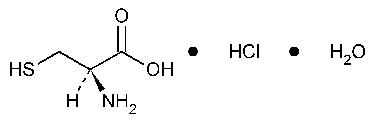Cysteine Hydrochloride
C3H7NO2S·HCl·H2O
175.64
L-Cysteine hydrochloride monohydrate.
L-Cysteine hydrochloride monohydrate [7048-04-6].
L-Cysteine hydrochloride monohydrate.
L-Cysteine hydrochloride monohydrate [7048-04-6].
Anhydrous 157.62 [52-89-1].
»Cysteine Hydrochloride contains not less than 98.5percent and not more than 101.5percent of C3H7NO2S·HCl,as L-cysteine hydrochloride,calculated on the dried basis.
Packaging and storage—
Preserve in well-closed containers.
Identification,Infrared Absorption á197Kñ.
Specific rotation á781Sñ:
between +5.7 and +6.8
and +6.8 .
.
Test solution:
80mg per mL,in 6Nhydrochloric acid.
Loss on drying á731ñ—
Dry it at a pressure not exceeding 5mm of mercury for 24hours:it loses between 8.0%and 12.0%of its weight.
Residue on ignition á281ñ:
not more than 0.4%.
Sulfate á221ñ—
Asolution containing 0.33g shows no more sulfate than corresponds to 0.10mLof 0.020Nsulfuric acid (0.03%).
Iron á241ñ:
0.003%.
Heavy metals,Method Iá231ñ:
0.0015%.
Chromatographic purity—
Adsorbent:
0.25-mm layer of chromatographic silica gel mixture.
N-Ethylmaleimide solution—
Prepare a solution of 4%N-ethylmaleimide in alcohol (w/v).
Test solution—
Transfer about 0.2g of Cysteine Hydrochloride,accurately weighed,to a 10-mLvolumetric flask,and dissolve in and dilute with water to volume.To 5.0mLof this solution,add 5.0mLof N-Ethylmaleimide solution.Allow the solution to stand for 5minutes before using.Apply 5µL.
Standard stock solution—
Dissolve 20mg of USPL-Cysteine Hydrochloride RSin 10.0mLof water,add 10.0mLof N-Ethylmaleimide solution,and mix.Allow the solution to stand for 5minutes before using.
Standard solution—
Transfer 5.0mLof the Standard stock solutionto a 100-mLvolumetric flask,and dilute with water to volume to obtain a solution having a concentration of about 0.05mg per mL.Apply 5µL.[NOTE—This solution has a concentration equivalent to about 0.5%of that of the Test solution.]
System suitability solution—
Transfer about 10mg of USPL-Tyrosine RSand 10mLof the Standard stock solutionto a 25-mLvolumetric flask,dilute with water to volume,and mix.Apply 5µL.
Spray reagent—
Dissolve 0.2g of ninhydrin in 100mLof a mixture of butyl alcohol and 2Nacetic acid (95:5).
Developing solvent system—
Prepare a mixture of butyl alcohol,glacial acetic acid,and water (60:20:20).
Procedure—
Proceed as directed for Thin-Layer Chromatographyunder Chromatography á621ñ.After air-drying the plate,spray with Spray reagent,and heat between 100 and 105
and 105 for about 15minutes.Examine the plate under white light.The chromatogram obtained from the System suitability solutionexhibits two clearly separated spots.Any secondary spot in the chromatogram obtained from the Test solutionis not larger or more intense than the principal spot in the chromatogram obtained from the Standard solution:not more than 0.5%of any individual impurity is found;and not more than 2.0%of total impurities is found.
for about 15minutes.Examine the plate under white light.The chromatogram obtained from the System suitability solutionexhibits two clearly separated spots.Any secondary spot in the chromatogram obtained from the Test solutionis not larger or more intense than the principal spot in the chromatogram obtained from the Standard solution:not more than 0.5%of any individual impurity is found;and not more than 2.0%of total impurities is found.
Organic volatile impurities,Method IVá467ñ:
meets the requirements.
Assay—
Accurately weigh about 250mg of Cysteine Hydrochloride into an iodine flask.Add 20mLof water and 4g of potassium iodide,and mix to dissolve.Cool the solution in an ice bath,and add 5mLof 3Nhydrochloric acid and 25.0mLof 0.1Niodine VS.Insert the stopper,and allow to stand in the dark for 20minutes.Titrate the excess iodine with 0.1Nsodium thiosulfate VS,adding 3mLof starch TSas the endpoint is approached.Perform a blank determination,and make any necessary correction.Each mLof 0.1Niodine is equivalent to 15.76mg of C3H7NO2S·HCl.
Auxiliary Information—
Staff Liaison:Lawrence Evans,III,Ph.D.,Scientist
Expert Committee:(DSN)Dietary Supplements:Non-Botanicals
USP28–NF23Page 566
Pharmacopeial Forum:Volume No.30(5)Page 1598
Phone Number:1-301-816-8389
